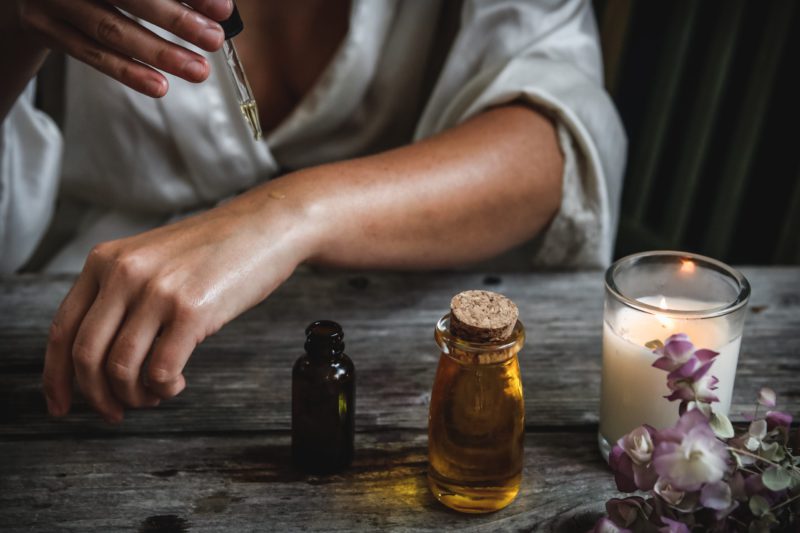Table of Contents
What is Pitta Dosha?
Pitta dosha is the Ayurvedic mind-body type that is associated with fire and water. It’s sharp and hot in nature and governs metabolism and all things heat-related in the mind and body. Pitta is the dosha of transformation. Think flow and fire! Our Agni—our digestive fire— is what we use to transform food.
Fire and water Pitta are responsible for this “fire” in our bellies, and if it’s out of balance, our entire physiology can be thrown for a loop. They are great to be around because their vibes are chill and exciting all at once.
In this post I will explain the complete features on Pitta Dosha, it’s subtypes, the balanced and imbalanced state. So first of all let’s examine Are you Pitta mind-body type?
Physical Characteristics of Pitta
- Have a medium build and gain or lose weight easily.
- Height is average.
- Physical features are sharp or pointed (e. g nose, chin, teeth)
- Energy and activity levels are high.
- Appetite is strong; Can eat large quantities of food.
- Bowel movements are regular; Occasionally have diarrhea.
- Perspire quite easily.
- The skin is oily and has a reddish tone.
- Eyes are penetrating and light in color.
- Prefer cooler weather and become irritable in hot weather.
Emotional Characteristics of Pitta
- Goal-oriented and achieve anything to which you put to mind.
- Have a good sense of humor.
- Have a strong intellect and enjoy learning new things.
- Have a natural ability to lead others.
- A perfectionist.
- Tend to become irritable, impatient, and angry.
- Critical of self and others.
- People think you are stubborn.
- Become irritable if you skip a meal.
- Enjoy the competition.
Consequently, now you must be sure that you have Pitta mind-body type constitution. Momentarily let’s examine Is your Pitta in balance?
Balanced Pitta
| Mind | Body |
|---|---|
| Goal-Oriented | Strong digestive system |
| Confident and Action-oriented | Good Immunity |
| Bold and Courageous | Medium body frame |
| Strong Intellect | Radiant and glowing Skin |
| Focussed | Sleeps through the night |
| Leadership Qualities | Good energy level |
| Quick in Grasping | Strong appetite and eat on time |
| Good Memory | Easily gains and loses weight |
| Bright and Warm | Oily scalp, bald |
| Good Analytical skils | Medium size nails and sharp eyes |
| Independent and ever set to have fun | Toned muscles |
Imbalanced Pitta
| Mind | Body |
|---|---|
| Controlling and Angry | Digestive issues |
| Impatience and Irritability | Excessive body heat |
| Over exert to achieve goals | Vision problems |
| Judgemental | Skin problems |
| Critical | Acute inflammation in body or joints |
| Argumentative | Acid Reflux, gastric, and heartburn |
| Snoopy | Migraines |
| Jealous | sharp hunger |
| Lack of motivation | Bleeding disorder |
The Five Sub doshas of Pitta
Pitta governs the metabolism and transformation of the mind and body. Within Pitta dosha, there are five distinct sub doshas that are responsible for moderating transformation in various parts of the physiology.
They are as follows:
Alochaka Pitta: Governs the functioning of the eyes, inner and outer vision. When out of balance, Alochaka Pitta can lead to bloodshot eyes or poor vision.
Bhrajaka Pitta: Governs the healthy glow of the skin. When out of balance, Bhrajaka Pitta can manifest as redness in the skin, skin irritation, rashes, or acne.
Sadhaka Pitta: Governs the emotional heart, desire, drive, decisiveness, and spirituality. If Sadhaka Pitta moves out of balance it can lead to demanding, perfectionist, and workaholic tendencies.
Pachak Pitta: Governs digestion, assimilation, and metabolism for health nutrients and tissues. If out of balance, Pachaka Pitta may lead to symptoms such as bloating, upset stomach, acid stomach, and food cravings.
Ranjaka Pitta: Governs healthy, toxin-free blood. If out of balance, Ranjaka Pitta can lead to toxins in the blood, anger, and even early graying of the hair
Ayurveda uses the term Agni to describe these enzymes and metabolic processes. Without Agni, it would be impossible to digest any food or
sensory experience.
Reasons Behind Imbalance of Pitta Dosha
- Consumption of Tea, alcohol, smoking, and junk food.
- Sedentary lifestyle.
- Too much of stress and tension.
- Suppressing anger and frustration.
- Long gaps between meals.
- Insufficient sleep.
Diseases caused by Pitta Dosha
When Pitta increases and disturbs the balance, the bile goes into various tissues and organs, as infections and inflammations occur due to that fact, for example, acne, urticaria, etc. The disorders of Pitta in general lead to the accumulation of toxins in the body because of indigestion and weak metabolism.
These toxins damage the cells, respectively the tissues, resulting in abnormalities in the function of organs and entire systems.
Increased Pitta causes processes that are similar to intensively burning fire. In such situations, people of the Pitta type lose their emotional balance very easily, as well as become irritable and anxious, angry, jealous and resentful.
Commonly speaking, the disorders and diseases caused by Pitta affect the skin, sweat glands, eyes, blood, gastrointestinal tract, adipose tissues. Of course, diseases and causes should not be accepted dogmatically – that any disease is caused only for one reason. Headache, for example, may be caused by Pitta, but it also may be related to an imbalance in one of the other two Doshas.
One of the worst diseases that can occur due to increased Pitta is the blood cancer. Gastric and intestinal diseases are different, with a variety of symptoms. These may include heartburn and burning sensations, strong sensitivity to fried foods.
Intensive salivation may occur due to the increased acidity. Since the bile is in excess, there is often a feeling of hunger, resulting in vomiting, as well as a very bitter taste in the mouth.
Diarrhea and constipation also can occur. The diseases that can be mentioned here are ulcers, colitis and gastritis, and so on.
The excessive bile, accumulated in the tissues, can lead to jaundice. The sclera and skin become yellow, as well as the stools and urine. Pitta may also cause bile diseases, as well as diseases of the:
- Liver
- Disturbances in the thyroid function
- High blood pressure and tinnitus
- Allergic rashes, dermatitis
- Myopia
- Hair loss
- Chronic fever
- Epilepsy and many more.
How to Balance Pitta Dosha with Diet
| Favor | Avoid | |
|---|---|---|
| Diet | Juicy, cooling foods with high water retention. And Cool to lukewarm drinks. | Hot spices, fried foods and cheese. |
| Grains and Pulses | Wheat, rice, barley, millet, corn, and oats. Mung beans and kidney beans. | Millet, brown rice and buck wheat. |
| Fruits | Grapes, pomegranate, banana, avocado, mango, coconut, melons, apple, pear, raisins, dates, figs, apricot, sweet orange, sweet pineapple, grapefruit, olive, persimmon, cashew fruit, papaya (small amounts), kiwi fruit. | Papaya, sour orange, sour peach, sour grapes, sour pineapple, berries, cranberries, prunes; sour fruits in general |
| Vegetables | Asparagus, artichoke, white pumpkin, okra (lady fingers), zucchini (courgette), fennel, corn on the cob, celery stalk, spinach, chicory, cauliflower, broccoli, cabbage, green beans, and potato, | Tomato, beetroot, carrot, radish, hot peppers, and raw onion |
| Sweetener | Sugar cane products (unprocessed white rock sugar/natural candy sugar is best; raw can sugar, unrefined brown sugar) | Molasses, ‘brown’ sugar (made from refined white sugar) |
| Oils | Ghee, olive and coconut oil. | Almond, corn and sesame oil. |
| Dairy | Milk, butter, ghee, sweet lassi and Paneer. | Sour milk products, yoghurt, sour lassi, cheese (especially old and salty), salty butter, quark, sour cream |
NOTE: Guidelines provided in this table are general. Specific adjustments for individual requirements may need to be made, e.g., food allergies, the strength of Agni, the season of the year, and degree of dosha predominance or aggravation.
Before making any changes to your diet, it is recommended that you check with your physician. This ayurvedic dietary guide is educational and is not intended to treat, cure, mitigate, or prevent any disease.
How to balance Pitta Dosha with Yoga
Pitta dosha is comprised mainly of the fire element (and secondary water) and tends to be hot and sharp by nature. Pitta types are often extremists and therefore should avoid overdoing it when it comes to exercise. The best exercises for Pitta types are medium in intensity and will avoid overheating the body and mind.
This means that exercising outdoors in the direct sunlight should always be avoided, especially at mid-day when both the sun and the Pitta are at their strongest point.
- Best time for exercise: Early morning or evening; avoid intense exercise at night as it can be too stimulating.
- Favor: Medium pace, moderate intensity, cool environments.
- Avoid: Direct sunlight, exercising mid-day (especially in summer), and competitive exercise.

How to Balance Pitta Dosha with Oil Massage

Benefits of Abhyanga for Pitta Dosha
The Pitta dominant people have a fiery mind and body type, so if Pitta Dosha is in balance they are full of joy, energy, and enthusiasm. For sensitive or overheated skin (Pitta), use a cooling carrier oil such as olive, sunflower, coconut, or ghee.
In Ayurvedic Yoga Massage the body is considered a reflection of the subconscious. Often, body tension or problems have their origin in unresolved emotional problems.
The benefits of Abhyanga for Pitta types lie mostly in the cooling effects achieved by gently massaging the entire body. This will loosen toxins and aid their elimination without generating too much heat. Moderate pressure should be used for Pitta massage, and the benefits include:
- Calming of the nervous system
- Strengthening of muscles and limbs.
- Moisturization of skin that has a natural tendency to be dry.
- Relaxation of tension in the scalp.
- Lustrous hair.
- Improved circulation and lymphatic drainage.
- Better sleep patterns.
How to balance Pitta Dosha with Meditation

Calm your mind with Meditation
The Pitta dosha people are prone to overthinking they often struggle to find the calm center necessary for effective meditation. However, for the same reason, it is important to find a meditation practice or method that does work for you so that you can bring unruly thoughts under control and achieve a state of calm relaxation that is vital for the maintenance of good health.
A regular meditation routine for yourself you will be amazed at how much more productive you become, whilst at the same time strengthening your immune system and building resistance to diseases of both the body and the mind.
For some people, a guided meditation is an excellent starting point and there are plenty of these to choose from now, mostly free to access on the internet.
Other benefits of meditation for Pittas include increased mental clarity and a renewed sense of purpose. You may find that after a meditation session your focus shifts slightly and you are more able to address the really important aspects of your life rather than dissipating your energy by attempting to do too many things at once.
Disclaimer
The sole purpose of these articles is to provide information about the tradition of Ayurveda. This information is not intended for use in the diagnosis, treatment, cure, or prevention of any disease.
If you have any serious acute or chronic health concerns, please consult a trained health professional who can fully assess your needs and address them effectively.
